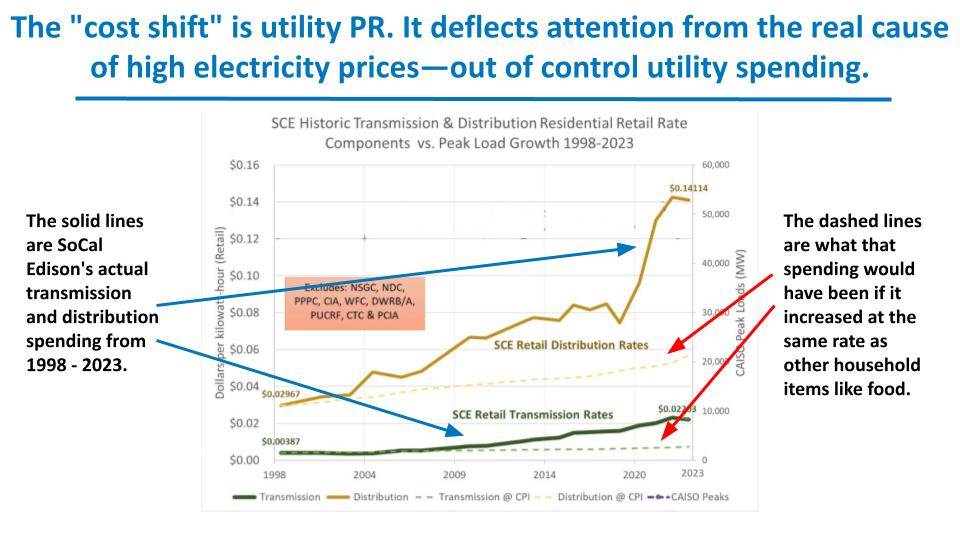The Natural Resources Defense Council (NRDC) is one of the country’s largest environmental groups. For decades, NRDC has worked to convince California politicians to side with utilities and energy companies—from enabling the Enron debacle, to undermining rooftop solar, to promoting the largest Utility Tax in the country.
NRDC’s co-founder became the leader of one of the country’s largest utilities. We believe this helps explain some of NRDC’s behavior.
NRDC’s close relationship with the utilities goes back to its co-founder, John Bryson. A few years after he started the group, he was appointed President of the CA Public Utilities Commission (CPUC). Two years after his CPUC term expired, he was hired as the CEO of Edison International (SoCal Edison’s parent company).
This is actually a classic example of the utility revolving door that continues to this day. In fact, PG&E’s current top lobbyist was a CPUC commissioner just a few years ago. Pending legislation would curtail this practice.
Our view: NRDC’s co-founder set the stage for a pattern of closeness between NRDC and the utility industry. There’s nothing wrong with a nonprofit working with the private sector when it has shared interests. However, in practice, NRDC’s closeness with the utility industry has led it to take positions that are counter to its environmental goals, while also harming consumers.
NRDC’s closeness with the energy industry helped bring about the Enron debacle.
In 1996, after heavy lobbying from NRDC and Enron, the California Legislature loosened the rules intended to ensure a reliable energy supply. Enron and NRDC’s collaboration was an intentional alliance that has been well-documented.
Most consumer and environmental advocates warned that these changes would lead to higher bills and blackouts. NRDC was the outlier, arguing that the changes would lead to more renewable energy and lower prices. It was NRDC’s advocacy that led on-the-fence legislators to approve the changes.
What happened next is well-known: Enron exploited the loopholes in the new system to hammer Californians with blackouts and massive price spikes.
Below are some in-depth accounts of this chapter in history and NRDC’s role in the mess that unfolded:
- LA Times, An Enron Tale of Strange Bedfellows
- The SF Bay Guardian, The Private Energy Elite: How the Energy Foundation has abandoned environmentalists and used big money to greenwash the private utility industry.
- American Affairs Journal, Enron after All: A History of Our Broken Energy Paradigm
- Counterpunch, Enron and the Green Seal
After Enron, NRDC allied with the utility industry to attack rooftop solar. They even hired a former PG&E lawyer to help.
NRDC was never held accountable for its role in the Enron scandal and continued its close relationship with the utility industry.
In 2012, the national utility trade group Edison Electric Institute launched a multi-pronged attack on rooftop solar. You can read about their strategy in these leaked internal documents.
Just two years later, NRDC released a joint agreement with Edison Electric Institute that called for “changes” to successful rooftop solar policies.
NRDC put that agreement into action in 2016, filing a joint proposal with the utilities to gut California’s net metering program.
That effort largely failed due to public opposition, so NRDC and the utilities tried again to gut rooftop solar in 2021. NRDC hired former PG&E lawyer Frank Lindh to represent the organization. This time, the effort succeeded, and the CPUC slashed the state’s successful net metering program.
By the end of 2023, thanks in part to NRDC’s efforts to “greenwash” the utilities’ strategies, rooftop solar sales were down around 80% and an estimated 17,000 solar workers lost their jobs.
More on Edison Electric Institute’s national campaign against rooftop solar from the nonprofit watchdog group Energy and Policy Institute:
- Utility Industry’s Campaign Against Rooftop Solar
- EEI used anti-clean energy campaigns as role models in political boot camp for utility execs
- Edison Electric Institute lead deceptive attack on rooftop solar in New Mexico
- Edison Electric Institute Caught Secretly Working To Influence FTC Solar Workshop
NRDC’s position on rooftop solar appears to be at odds with their position on California’s renewable energy goals.
California plans to be completely powered by renewable energy by 2045, a goal that NRDC supports. To get there, the state Energy Commission says that we will need to increase renewable energy substantially over the next 20 years. This includes both more big solar and wind farms, and it also includes tripling the amount of rooftop solar we have today.
But rooftop solar has now fallen off a cliff thanks to the CPUC’s “NEM3” decision—supported by NRDC. Now, California is missing a critical leg of the stool they need to get to 100% renewable by 2045.
NRDC repeats anti-solar utility arguments invented by the utilities.
NRDC is a leading proponent of the “cost shift” claim that rooftop solar is the main culprit for unsustainable electricity bills.
This claim was created in 2012 by the Edison Electric Institute (start on p. 23 of their leaked strategy memo). The supporting evidence for NRDC’s claim largely comes from the work of utility energy consulting firm Energy + Environmental Economics (E3), or from other research firms that replicate E3’s methods. E3’s client list contains thirty-two investor owned utilities including PG&E, SDG&E, and SoCal Edison. E3’s work is riddled with problematic and cherry picked assumptions that grossly distort the truth about rooftop solar, which we itemize in this white paper.
For many years, the CPUC has contracted with E3 to evaluate California’s rooftop solar program. It’s bad enough that the CPUC uses E3 to do its math on rooftop solar, which is an obvious conflict of interest. It’s really unfortunate when an independent nonprofit like NRDC also chooses to rely on that compromised information.
NRDC’s latest proposal—a big Utility Tax on all ratepayers—will further harm rooftop solar while also increasing bills on millions of non-solar users.
NRDC is currently pushing for a big uncapped Utility Tax. The leading Utility Tax proposal would start at $24/month and increase from there, as rates also rise. Most ratepayers would pay this Utility Tax regardless of how much electricity they use. Ratepayers would get a small one-time, temporary reduction in per kilowatt hour rates in exchange.
NRDC falsely claims that their Utility Tax proposal will decrease bills on low-income households. They also say the Utility Tax will get people to switch to electric appliances.
The reality: even a $24/month Utility Tax will increase bills on millions of working people and retirees who don’t use a lot of electricity. This includes people who live in apartments or small homes. It also includes folks who actively conserve energy or invest in solar panels.
How does NRDC get away with making such a misleading claim? By only talking about the impact on average-sized homes. The problem with that approach: one-fifth of California households are smaller than the average. NRDC is aware of this critique, but has not addressed it.
In addition, a big Utility Tax won’t get people to electrify because it will still be cheaper for people to stick with gas. The Utility Tax simply doesn’t bring electricity rates down enough to be competitive with gas.
Finally, NRDC’s Utility Tax proposal won’t bring down the cost of electricity in California. It simply rearranges who pays what—with millions of working class people getting the short end of the stick.
Meanwhile, this big Utility Tax will enrich the utilities by guaranteeing a stream of income that ratepayers can’t reduce, no matter what they do.
Rooftop solar is key to making electricity more affordable for everyone, and meeting our state’s clean energy goals. It’s good for the environment, and saves all ratepayers money.
Consider:
- In 2018, the CA Independent Systems Operator scaled back $2.6 billion of transmission and distribution because of rooftop solar and energy efficiency. Economists estimate that solar roofs save everyone an additional $3 billion every year in avoided generation costs.
- A 2021 in-depth analysis by Vibrant Clean Energy modeling found that scaling up both utility-scale renewables and rooftop solar could be $120 billion cheaper over 30 years than utility-scale alone.
- The Protect Our Communities Foundation has shown how rooftop solar and batteries could have eliminated or reduced the cost of several major grid projects and saved ratepayers billions of dollars.
Electricity bills are too high because of out-of-control utility spending, not rooftop solar.
Out-of-control utility spending is the real reason for California’s high electricity rates. We will not solve this problem by slashing rooftop solar or by rearranging who pays with a big Utility Tax. This chart showing SoCal Edison’s spending helps illustrate what’s going on:

Source: Richard McCann: Historic SCE Retail Rate Components: 1998-2023, February 2024, CAISO load line removed for clarity (full presentation)
Utilities get a guaranteed 8-12% profit from every dollar they spend on infrastructure, automatically collected from ratepayers. The more they spend, the more they earn. This a perverse incentive, and the root of the problem. (See p. 26 of this CPUC report)
The way to rein in out-of-control utility spending is to build less transmission and distribution lines. This approach would reduce utility profits, but it is the only way out of this mess.
NRDC is out of step with hundreds of organizations, cities, and schools.
NRDC’s position on rooftop solar is out of step with the state’s leading consumer advocacy organizations like Consumer Watchdog and CALPIRG, environmental leaders like the Center for Biological Diversity and Environmental Working Group, environmental justice and immigrant rights leaders, over 600 environmental groups, cities, schools, and businesses.
NRDC’s Utility Tax proposal is opposed by more than 240 groups. This includes organizations represent affordable housing, tenants rights, environmental justice, and environmental protection.
Our view: NRDC should do better to live up to their stated values or mission.
Californians can’t afford to have a major environmental group working at cross purposes with their interests.
Rooftop solar is a major solution to so many problems. We ask NRDC to stop working to squash rooftop solar. Let’s work together to get rooftop solar growing again for everyone—renters, homeowners, schools, farms, businesses, churches and more.
Let’s also work together to address the real cause of skyrocketing electricity bills—out of control utility spending. Imagine what we could accomplish by working together!

